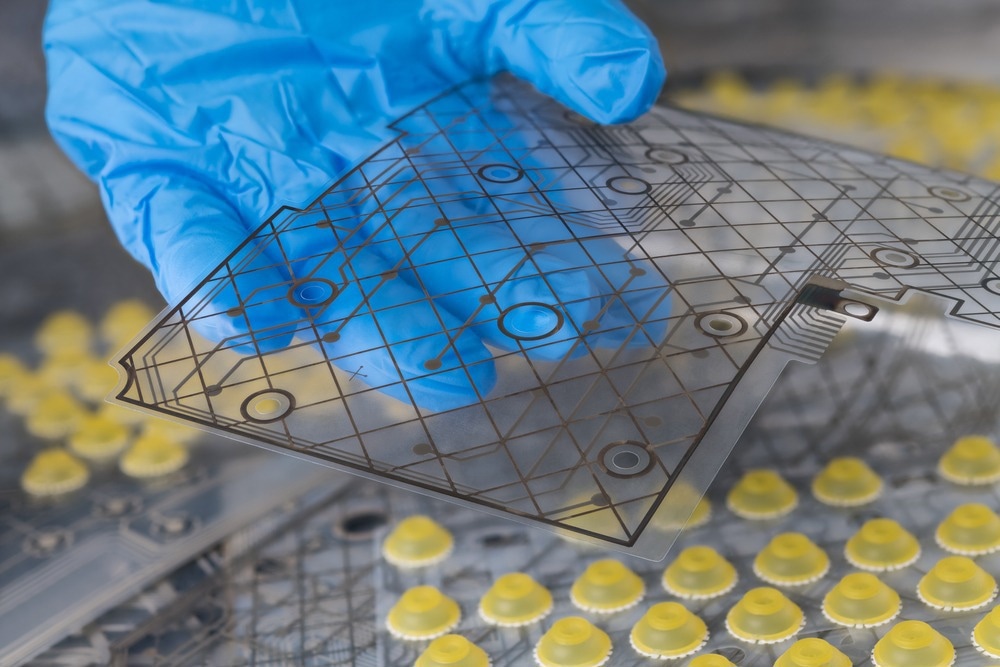Flexible transparent electrodes (FTEs) with good optical and electrical characteristics, mechanical durability, and environmental adaption are critical for industrializing wearable electronics. Because of their remarkable photophysical characteristics and mechanical stability, silver nanowires (AgNWs) are commonly used for making flexible transparent electrodes.

Study: Highly Stable Silver Nanowires/Biomaterial Transparent Electrodes for Flexible Electronics. Image Credit: KPixMining/Shutterstock.com
However, the excessive surface roughness and low durability of AgNWs-based flexible transparent electrodes significantly restrict their practical uses. A recent study published in the journal ACS Applied Materials & Interfaces addresses this problem by integrating AgNWs with the eco-friendly and cytoprotective biomaterial propolis to create highly stable, flexible transparent electrodes.
AgNWs-based Transparent Electrodes: Overview and Challenges
Flexible transparent electrodes (FTEs) are a critical element of wearable electronics, like thin-film photovoltaic panels, organic light-emitting diodes (OLEDs), supercapacitors, and detectors. Conventional indium-tin-oxide (ITO) electrodes have intrinsic fragility, unavailability, and a problematic manufacturing procedure.
As a result, numerous novel flexible transparent electrodes, such as thin metal sheets, metal nanorods, and conductive polymers, have been created as viable replacements for conventional indium-tin-oxide (ITO) electrodes.
Because of their high transparency, minimal sheet resistivity, and remarkable mechanical adaptability, silver nanowires (AgNWs) stand out among these novel FTEs. Transparent electrodes based on AgNWs have been used in semiconductor applications, adaptable supercapacitors, solar cells, detectors, and air purifiers.
However, AgNWs-based flexible transparent electrodes have several intrinsic flaws. Because of the significant surface roughness of AgNWs, short-circuiting occurs across OLEDs and photovoltaic panels. Furthermore, the stability issues of AgNWs limit their industrial-scale applicability in wearable electronics.
Limitations of Currently Used Methods
To date, techniques such as contact transference and coating adapted layers have been explored to alleviate the problems associated with AgNWs-based transparent electrodes. Coating techniques, as opposed to the difficult transfer procedure, offer the benefit of one-step production and have been widely utilized to embellish AgNWs electrodes.
However, there have been few reports of AgNWs-based transparent electrodes achieving low surface irregularity and good stability without losing photophysical characteristics.
2D materials like graphene oxide, as well as metal oxides such as zinc oxide and titanium dioxide, have been proposed to decorate AgNWs to improve the durability of transparent electrodes. Nonetheless, these nanomaterials often cause AgNWs-based transparent electrodes to lose opacity.
Conductive polymers have also been employed as modifying materials in AgNWs-based transparent electrodes because of their electrical properties. However, these polymers deteriorate at high temperatures, and their intrinsic acidity ultimately triggers the chemical erosion of AgNWs networks.
Development of Biocompatible AgNWs-based Transparent Electrodes
Metal films, such as gold and platinum, can be employed to create homogenous and durable transparent electrodes by electrolytic or physical vapor deposition techniques. Aside from electrode characteristics, a renewable manufacturing technique is critical for decreasing pollution generated by complicated fabrication procedures.
In this context, a biodegradable chitosan compound for altering AgNWs electrodes was recently reported. Although the smooth surfaces of the AgNWs/chitosan electrodes were remarkable, chitosan must be dissolved in an acidic solution before the fabrication process. Furthermore, chitosan disintegrates at high temperatures and changes color.
As a result, highly durable AgNWs-based transparent electrodes with outstanding optoelectrical capabilities and long-term durability using sustainable, biodegradable materials are still urgently needed for large-scale industrial applications.
Highlights and Key Developments of the Study
In this study, the researchers report extremely stable AgNWs-based hybrid adaptable transparent electrodes containing biomaterial propolis. Propolis is a bee-collected compound with biodegradable, cytoprotective, and antibacterial characteristics. It may be obtained straight from the environment and needs little preparation.
The flat surface and high durability of the hybrid transparent electrodes were made possible by the biomaterial propolis's outstanding film-forming capability and thermal properties. The transparent electrodes demonstrated enhanced optoelectrical efficiency, minimal sheet resistance, good optical clarity, and a flat texture.
More notably, the transparent electrodes demonstrated good physical durability and environmental adaptation testing stability. After 10,000 bending cycles and exposure to 60 °C and 85% moisture, the hybrid transparent electrodes kept their sheet resistance and surface shape.
Modular white OLEDs and pressure detectors were also created to demonstrate the capabilities of the as-developed transparent electrodes. White OLEDs outperformed rigid devices in terms of current efficiency and mechanical endurance. The resulting pressure sensors were also environmentally stable and customizable.
Based on these results, it is reasonable to conclude that the transparent electrodes created in this work may be utilized to create environmentally benign and extremely stable adaptable electronics.
Reference
Qin, Y. et al. (2022). Highly Stable Silver Nanowires/Biomaterial Transparent Electrodes for Flexible Electronics. ACS Applied Materials & Interfaces. Available at: https://pubs.acs.org/doi/10.1021/acsami.2c09153
Disclaimer: The views expressed here are those of the author expressed in their private capacity and do not necessarily represent the views of AZoM.com Limited T/A AZoNetwork the owner and operator of this website. This disclaimer forms part of the Terms and conditions of use of this website.